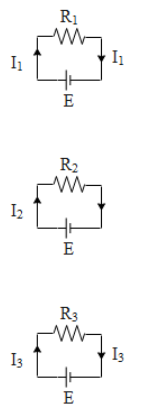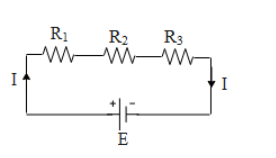
Answer
437.1k+ views
Hint: It is given to us that the resistances initially are connected individually to the battery. The corresponding current in the circuit is given and hence using ohm's law we will determine the resistance of the individual resistors in the circuit. Electric current in series circuits remains the same. Hence again using ohm's law since they are connected to the same battery we will determine the current in the circuit.
Formula used:
$V=IR$
$R={{R}_{1}}+{{R}_{2}}+{{R}_{3}}$
Complete answer:
To begin with let us first define ohm's law.
The ohms law is defined as current flowing through the metallic wire is directly proportional to the potential difference provided the temperature remains the same. If a battery is connected across a resistor of resistance (R) and the current in the circuit is(I), than by ohm's law the potential difference (V)is given by,
$V=IR$
Initially it is given to us that the resistances are connected individually across the battery. Let the resistance of the three resistors be,${{R}_{1}},{{R}_{2}}\text{ and }{{R}_{3}}.$ Let the emf of the battery be (E) with negligible internal resistance. Therefore from ohms law the current in individual resistances is equal to,

$\begin{align}
& E={{I}_{1}}{{R}_{1}},\Rightarrow {{R}_{1}}=\dfrac{E}{{{I}_{1}}}=\dfrac{E}{1}=E\Omega \\
& E={{I}_{2}}{{R}_{2}},\Rightarrow {{R}_{2}}=\dfrac{E}{{{I}_{2}}}=\dfrac{E}{2}=\dfrac{E}{2}\Omega \\
& E={{I}_{3}}{{R}_{3}},\Rightarrow {{R}_{3}}=\dfrac{E}{{{I}_{3}}}=\dfrac{E}{4}=\dfrac{E}{4}\Omega \\
\end{align}$
Further it is given to us all the above resistances are connected in series across the same battery. The equivalent resistance of the resistors in series gets added up. Hence equivalent resistance of all the three resistors in series is,

$\begin{align}
& R={{R}_{1}}+{{R}_{2}}+{{R}_{3}} \\
& R=E+\dfrac{E}{2}+\dfrac{E}{4} \\
& \Rightarrow R=\dfrac{14E}{8}\Omega =\dfrac{7E}{4}\Omega \\
\end{align}$
Hence by ohm's law the current in the circuit(I$I$) is equal to,
$\begin{align}
& E=IR \\
& \Rightarrow E=I\dfrac{7E}{4} \\
& \Rightarrow 1=I\dfrac{7}{4} \\
& \Rightarrow I=\dfrac{4}{7}A \\
\end{align}$
Hence the correct answer of the above question is option c.
Note:
It is to be noted that the internal resistance of the battery is taken to be negligible. If the battery has finite internal resistance then we will not be able to ignore the internal resistance of the battery. As a result the potential difference across each of the resistors will not be the same.
Formula used:
$V=IR$
$R={{R}_{1}}+{{R}_{2}}+{{R}_{3}}$
Complete answer:
To begin with let us first define ohm's law.
The ohms law is defined as current flowing through the metallic wire is directly proportional to the potential difference provided the temperature remains the same. If a battery is connected across a resistor of resistance (R) and the current in the circuit is(I), than by ohm's law the potential difference (V)is given by,
$V=IR$
Initially it is given to us that the resistances are connected individually across the battery. Let the resistance of the three resistors be,${{R}_{1}},{{R}_{2}}\text{ and }{{R}_{3}}.$ Let the emf of the battery be (E) with negligible internal resistance. Therefore from ohms law the current in individual resistances is equal to,

$\begin{align}
& E={{I}_{1}}{{R}_{1}},\Rightarrow {{R}_{1}}=\dfrac{E}{{{I}_{1}}}=\dfrac{E}{1}=E\Omega \\
& E={{I}_{2}}{{R}_{2}},\Rightarrow {{R}_{2}}=\dfrac{E}{{{I}_{2}}}=\dfrac{E}{2}=\dfrac{E}{2}\Omega \\
& E={{I}_{3}}{{R}_{3}},\Rightarrow {{R}_{3}}=\dfrac{E}{{{I}_{3}}}=\dfrac{E}{4}=\dfrac{E}{4}\Omega \\
\end{align}$
Further it is given to us all the above resistances are connected in series across the same battery. The equivalent resistance of the resistors in series gets added up. Hence equivalent resistance of all the three resistors in series is,

$\begin{align}
& R={{R}_{1}}+{{R}_{2}}+{{R}_{3}} \\
& R=E+\dfrac{E}{2}+\dfrac{E}{4} \\
& \Rightarrow R=\dfrac{14E}{8}\Omega =\dfrac{7E}{4}\Omega \\
\end{align}$
Hence by ohm's law the current in the circuit(I$I$) is equal to,
$\begin{align}
& E=IR \\
& \Rightarrow E=I\dfrac{7E}{4} \\
& \Rightarrow 1=I\dfrac{7}{4} \\
& \Rightarrow I=\dfrac{4}{7}A \\
\end{align}$
Hence the correct answer of the above question is option c.
Note:
It is to be noted that the internal resistance of the battery is taken to be negligible. If the battery has finite internal resistance then we will not be able to ignore the internal resistance of the battery. As a result the potential difference across each of the resistors will not be the same.
Recently Updated Pages
How many sigma and pi bonds are present in HCequiv class 11 chemistry CBSE

Mark and label the given geoinformation on the outline class 11 social science CBSE

When people say No pun intended what does that mea class 8 english CBSE

Name the states which share their boundary with Indias class 9 social science CBSE

Give an account of the Northern Plains of India class 9 social science CBSE

Change the following sentences into negative and interrogative class 10 english CBSE

Trending doubts
Difference Between Plant Cell and Animal Cell

Difference between Prokaryotic cell and Eukaryotic class 11 biology CBSE

Fill the blanks with the suitable prepositions 1 The class 9 english CBSE

Differentiate between homogeneous and heterogeneous class 12 chemistry CBSE

Which are the Top 10 Largest Countries of the World?

One cusec is equal to how many liters class 8 maths CBSE

Give 10 examples for herbs , shrubs , climbers , creepers

The mountain range which stretches from Gujarat in class 10 social science CBSE

The Equation xxx + 2 is Satisfied when x is Equal to Class 10 Maths



